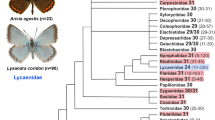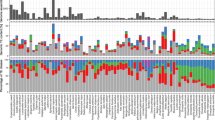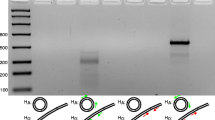Abstract
At the turn of the 21st century, the use of molecular and molecular cytogenetic methods led to revolutionary advances in systematics of insects and other arthropods. Analysis of nuclear and mitochondrial genes, as well as investigation of structural rearrangements in the mitochondrial chromosome convincingly supported the Pancrustacea hypothesis, according to which insects originated directly from crustaceans, whereas myriapods are not closely related to them. The presence of the specific telomeric motif TTAGG confirmed the monophyletic origin of arthropods (Arthropoda) and the assignment of tongue worms (Pentastomida) to this type. Several different types of telomeric sequences have been found within the class of insects. Investigation of the molecular organization of these sequences may shed light on the relationships between the orders Diptera, Siphonaptera, and Mecoptera and on the origin of such enigmatic groups as the orders Strepsiptera, Zoraptera and suborder Coleorrhyncha.
Similar content being viewed by others

References
Kristensen, N.P., Phylogeny of Insect Orders, Ann. Rev. Entomol., 1981, vol. 26, pp. 135–157.
Kluge, N.Yu., Sovremennaya sistematika nasekomykh (Modern Systematics of Insects), part 1: Printsipy sistematiki zhivykh organizmov i obshchaya sistematika nasekomykh s klassifikatsiei pervichnobeskrylykh i drevnekrylykh (Principles of Systematics of Living Organisms and the General System of Insects with Classification of Primary Wingless and Paleopterous Insects), St. Petersburg: Lan’, 2000.
Telford, M.J. and Thomas, R., Demise of the Atelocerata?, Nature, 1995, vol. 376, pp. 123–124.
Crampton, G.C., Phylogeny and Classification of Insects, J. Ent. Soc., 1924, vol. 5, pp. 153–157.
Turbeville, J.M., Pfeifer D.A., Field, K.G., and Raft, R.A., The Phylogenetic Status of Arthropods, as Inferred from 18S rRNA Sequences, Mol. Biol. Evol., 1991, vol. 8, no. 5, pp. 669–686.
Ballard, J.W.O., Olsen, G.J., Faith, D.P., et al., Evidence from 12S Ribosomal RNA Sequences That Onychophoras Are Modified Arthropods, Science, 1992, vol. 258, pp. 1345–1347.
Friedrich, M. and Tautz, D., Ribosomal DNA Phylogeny of the Major Extant Arthropod Classes and the Evolution of Myriapods, Nature, 1995, vol. 376, pp. 165–167.
Zrzavy, J., The Basic Body Plan of Arthropods: Insights from Evolutionary Morphology and Developmental Biology, J. Evol. Biol., 1997, vol. 10, pp. 353–367.
Pisani, D., Poling, L.L., Lyons-Weiler, M., and Hedges, S.B., The Colonization of Land by Animals: Molecular Phylogeny and Divergence Times among Arthropods, BMC Biol., 2004, vol. 2, pp. 1–10.
Wheeler, W.C., Cartwright, P., and Hayashi, C.Y., Arthropod Phylogeny: A Combined Approach, Cladistics, 1993, vol. 9, pp. 1–39.
Bitsch, J., Bitsch, C., Bourgoin, T., and D’Haese, C., The Phylogenetic Position of Early Hexapod Lineages: Morphological Data Contradict Molecular Data, Syst. Entomol., 2004, vol. 29, pp. 433–440.
Zherikhin, V.V., Ponomarenko, A.G., and Rasnitsyn, A.P., Vvedenie v paleoentomologiyu (Introduction to Paleoentomology), Moscow: KMK, 2008.
Hassanin, A., Phylogeny of Arthropoda Inferred from Mitochondrial Sequences: Strategies for Limiting the Misleading Effects of Multiple Changes in Pattern and Rates of Substitution, Mol. Phyl. Evol., 2006, vol. 38, pp. 100–116.
Mallatt, J.M., Garey, J.R., and Shultzc, J.W., Ecdysozoan Phylogeny and Bayesian Inference: First Use of Nearly Complete 28S and 18S rRNA Gene Sequences to Classify the Arthropods and Their Kin, Mol. Phyl. Evol., 2004, vol. 31, pp. 178–191.
Gat, Y.-H., Song, D.-X., Sun, H.-Y., and Zhoul, K.-Y., Myriapod Monophyly and Relationships among Myriapod Classes Based on Nearly Complete 28S and 18S rDNA Sequences, Zool. Sci., 2006, vol. 23, pp. 1101–1108.
Nardi, F., Spinsanti, G., Boore, J.L., et al., Hexapod Origins: Monophyletic or Paraphyletic?, Science, 2003, vol. 299, pp. 1887–1889.
Dunn, C.W., Hejnol, A., Matus, D.Q., et al., Broad Phylogenomic Sampling Improves Resolution of the Animal Tree of Life, Nature, 2008, vol. 452, pp. 745–749.
Giribet, G., Edgecombe, G.D., and Wheeler, W.C., Arthropod Phylogeny Based on Eight Molecular Loci and Morphology, Nature, 2001, vol. 413, pp. 157–161.
Giribet, G., Edgecombe, G.D., Carpenter, J.M., et al., Is Ellipura Monophyletic? A Combined Analysis of Basal Hexapod Relationships with Emphasis on the Origin of Insects, Org. Div. Evol., 2004, vol. 4, pp. 319–340.
Shultz, J.W. and Regier, J.C., Phylogenetic Analysis of Arthropods Using Two Nuclear Protein-Encoding Genes Supports a Crustacean+Hexapod Clade, Proc. R. Soc. London, Ser. B, 2000, vol. 267, pp. 1011–1019.
Lukhtanov, V.A. and Kuznetsova, V.G., Molecular and Cytogenetic Approaches to Species Diagnostics, Systematics, and Phylogenetics, Zh. Obshch. Biol., 2009, vol. 70, no. 5, pp. 415–437.
Hickson, R.E., Simon, R.E., Cooper, A., et al., Conserved Sequence Motifs, Alignment, and Secondary Structure for the Third Domain of Animal 12S rRNA, Mol. Biol. Evol., 1996, vol. 13, pp. 150–169.
Xie, Q., Tian, X., Qin, Y., and Bu, W., Phylogenetic Comparison of Local Length Plasticity of the Small Subunit of Nuclear rDNAs among All Hexapoda Orders and the Impact of Hyper-Length-Variation on Alignment, Mol. Phyl. Evol., 2009, vol. 50, pp. 310–316.
Ronquist, F. and Huelsenbeck, J.P., MrBayes 3: Bayesian Phylogenetic Inference under Mixed Models, Bioinformatics, 2003, vol. 19, pp. 1572–1574.
Misof, B., Niehuis, O., Bischoff, I., et al., Towards to 18S Phylogeny of Hexapods: Accounting for Group-Specific Character Covariance in Optimized Mixed Nucleotide/Doublet Models, Zoology, 2007, vol. 110, pp. 409–429.
Kjer, K.M., Aligned 18S and Insect Phylogeny, Syst. Biol., 2004, vol. 53, pp. 506–514.
Regier, J.C., Shultz, J.W., Ganley, A.R.D., et al., Resolving Arthropod Phylogeny: Exploring Phylogenetic Signal within 41 Kb of Protein-Coding Nuclear Gene Sequence, Syst. Biol., 2008, vol. 57, no. 6, pp. 920–938.
Felsenstein, J., Inferring Phylogenies, Sunderland, Massachusetts Sinauer Ass., 2004.
Shcherbakov, D.E., Controversies over the Insect Origin Revisited: AMBA Projects AM/PFICM98/1.99, in Proceedings of the First International Paleontological Conference, Moscow, 1998, pp. 141–148.
Boore, J.L., Collins, T.M., Stanton, D., et al., Deducing the Pattern of Arthropod Phylogeny from Mitochondrial DNA Rearrangements, Nature, 1995, vol. 376, pp. 163–165.
Ballard, J.W.O. and Whitlock, M.C., The Incomplete Natural History of Mitochondria, Mol. Ecol., 2004, vol. 13, pp. 729–744.
Lavrov, D.V. and Lang, B.F., Poriferan mtDNA and Animal Phylogeny Based on Mitochondrial Gene Arrangements, Syst. Biol., 2005, vol. 54, pp. 651–659.
Sturtevant, A.H., Dobzhansky, T., Inversions in the Third Chromosome of Wild Races of Drosophila pseudoobscura, and Their Use in the Study of the History of the Species, Proc. Natl. Acad. Sci. USA, 1936, vol. 22, pp. 448–450.
Boore, J.L., Lavrov, D.V., and Brown, W.M., Gene Translocation Links Insects and Crustaceans, Nature, 1998, vol. 392, pp. 667–668.
Aleshin, V.V., Mikhailov, K.V., Konstantinova, A.V., et al., On the Phylogenetic Position of Hexapoda within the Clade Pancrustacea, Mol. Biol., 2009, vol. 43, no. 5, pp. 866–881.
Glenner, H., Thomsen, P.F., Hebsgaard, M.B., et al., The Origin of Insects, Science, 2006, vol. 314, pp. 1883–1884.
Shao, R., Kirkness, E.F., and Barker, S.C., The Single Mitochondrial Chromosome Typical of Animals Has Evolved into 18 Minichromosomes in the Human Body Louse, Pediculus humanus, Genet. Res., 2009, vol. 19, pp. 904–912.
Rand, D.M., ’Why Genomes in Pieces?’ Revisited: Sucking Lice Do Their Own Thing in mtDNA Circle Game, Genet. Res., 2009, vol. 19, pp. 700–702.
Zakian, V.A., Telomeres: Beginning to Understand the End, Science, 1995, vol. 270, pp. 1601–1607.
Traut, W., Szczepanowski, M., Vitková, M., et al., The Telomere Repeat Motif of Basal Metazoa, Chromosome Res., 2007, vol. 15, no. 3, pp. 371–382.
Vitková, M., Král, J., Traut, W., et al., The Evolutionary Origin of Insect Telomeric Repeats, (TTAGG)n, Chromosome Res., 2005, vol. 13, pp. 145–156.
Chesunov, A.V., Pentastomida Casus: Special Problem in the Context of Modern Phylogenetics, Zh. Obshch. Biol., 2002, vol. 63, no. 3, pp. 209–226.
Lavrov, D.V., Brown, W.M., and Boore, J.L., Phylogenetic Position of the Pentastomida and (Pan)Crustacean Relationships, Proc. R. Soc. London, Ser. B, 2004, vol. 271, pp. 537–544.
Pelliccia, F., Volpi, E.V., Lanza, V., et al., Telomeric Sequences of Asellus aquaticus (Crustacea, Isopoda), Heredity, 1994, vol. 72, pp. 78–80.
Frydrychová, R., Grossmann, P., Truba, P., et al., Phylogenetic Distribution of TTAGG Telomeric Repeats in Insects, Genome, 2004, vol. 47, pp. 163–178.
Ouvrard, D., Campbell, B.C., and Chan, K.L., I8S rRNA Secondary Structure and Phylogenetic Position of Peloridiidae (Insecta, Hemiptera), Mol. Phyl. Evol., 2000, vol. 16, no. 3, pp. 403–417.
Forero, D., The Systematics of the Hemiptera, Rev. Colombiana Entomol., 2008, vol. 34, no. 1, pp. 1–21.
Rosen, M., and Edström, J., DNA Structures Common for Chironomid Telomeres Terminating with Complex Repeats, Insect Mol. Biol., 2000, vol. 9, pp. 341–347.
Walter, M.F., Bozorgnia, L., Maheshwari, A., and Biessmann, H., The Rate of Terminal Nucleotide Loss from a Telomere of the Mosquito Anopheles gambiae, Insect Mol. Biol., 2001, vol. 10, pp. 105–110.
Biessmann, H. and Mason, J.M., Telomerase-Independent Mechanisms of Telomere Maintenance, Cell Mol. Life Sci., 2003, vol. 60, pp. 2325–2333.
Whiting, M.F., Phylogeny of the Holometabolous Insect Orders: Molecular Evidence, Zool. Scripta, 2002, vol. 31, pp. 3–15.
Bonneton, F., Brunei, F.G., Kathirithamby, J., and Laudet, V., The Rapid Divergence of the Ecdysone Receptor Is a Synapomorphy for Mecopterida That Clarifies the Strepsiptera Problem, Insect Mol. Biol., 2006, vol. 15, no. 3, pp. 351–362.
Rodendorf, B.B., Osnovy paleontologii: Chlenistonogie—trakheinye i khelitserovye (Fundamentals of Paleontology: Artropoda—Tracheids and Chelicerids), Moscow: Nauka, 1962.
Kristensen, N.P., Forthy Years’ Insect Phylogenetic Systematics, Zool. Beitrage N.F., 1995, vol. 36, pp. 83–124.
Engel, M.S. and Grimaldi, D.A., A Winged Zorotypus in Miocene Amber from the Dominican Republic (Zoraptera: Zorotypidae), with Discussion on Relationships of and within the Order, Acta Geol. Hisp., 2000, vol. 35, pp. 149–164.
Kuznetsova, V.G., Nokkala, S., and Shcherbakov, D.E., Karyotype, Reproductive Organs, and Pattern of Gametogenesis in Zorotypus hubbardi Caudell (Insecta: Zoraptera, Zorotypidae), with Discussion on Relationships of the Order, Can. J. Zool., 2002, vol. 80, pp. 1047–1054.
Kuznetsova, V.G., The Chromosomes of the Holokinetic Type and Their Distribution among Insects and Other Invertebrate Animals, in Kariosistematika bespozvonochnykh zhivotnykh (Karyosystematics of Invertebrates), Leningrad: Zool. Inst. Akad. Nauk SSSR, 1979, pp. 5–19.
Yoshizava, K. and Johson, K.P., Aligned 18S for Zoraptera (Insecta): Phylogenetic Position and Molecular Evolution, Mol. Phyl. Evol., 2005, vol. 37, pp. 572–580.
Yoshizawa, K., The Zoraptera Problem: Evidence for Zoraptera and Embiodea from the Wing Base, Syst. Entomol., 2007, vol. 32, pp. 197–204.
Terry, M.D. and Whiting, M.F., Mantophasmatodea and Phylogeny of the Lower Neopterous Insects, Cladistics, 2005, vol. 21, pp. 240–257.
Author information
Authors and Affiliations
Corresponding author
Additional information
Original Russian Text © V.A. Lukhtanov, V.G. Kuznetsova, 2010, published in Genetika, 2010, Vol. 46, No. 9, pp. 1258–1265.
Rights and permissions
About this article
Cite this article
Lukhtanov, V.A., Kuznetsova, V.G. What genes and chromosomes say about the origin and evolution of insects and other arthropods. Russ J Genet 46, 1115–1121 (2010). https://doi.org/10.1134/S1022795410090279
Received:
Published:
Issue Date:
DOI: https://doi.org/10.1134/S1022795410090279



